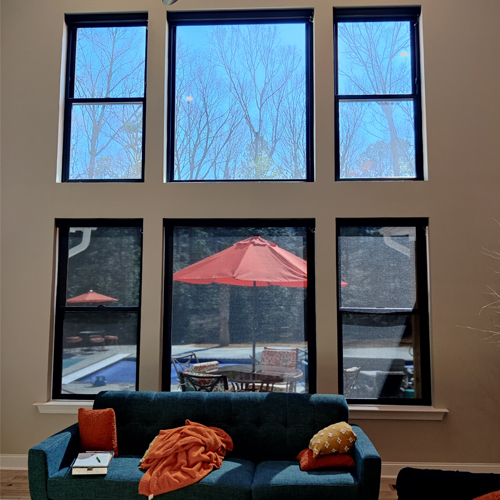Residential Window Tint for Big Windows: Keep Convenience and Design
Residential Window Tint for Big Windows: Keep Convenience and Design
Blog Article
How Residential Home Window Tinting Improves Your Home's Power Efficiency
Residential window tinting provides a compelling remedy for homeowners seeking to improve energy effectiveness within their living areas. By using specialized movies to home windows, it efficiently decreases warmth transfer, consequently maintaining interior temperatures and reducing the requirement for extreme home heating or air conditioning.
Recognizing Home Window Tinting
Recognizing home window tinting is crucial for homeowners seeking to enhance both convenience and power performance in their home. Residential Window Tint. Home window tinting entails the application of a slim movie to the interior or exterior surface of glass windows. This movie can dramatically regulate the quantity of sunlight and heat that enters a home, thus influencing interior environment conditions
There are different types of home window tinting films readily available, each with unique homes. The effectiveness of home window tinting is typically measured by its Visible Light Transmission (VLT) portion, which indicates how much light can pass via the film.
Advantages of Power Performance
Home window tinting not only boosts aesthetics yet also plays a substantial function in boosting energy performance within domestic rooms. By reducing warm transfer through windows, colored films produce an extra stable interior environment, which can result in substantial reductions in energy intake for cooling and heating. This power efficiency equates right into lower utility expenses, providing house owners with significant long-term cost savings.

In addition, window tinting enhances the convenience of living areas. By minimizing glow and blocking damaging UV rays, tinted home windows produce a more pleasant setting, which can cause enhanced well-being for owners. The security against UV rays also aids maintain furnishings and flooring from fading, contributing to the long life of house things.
Exactly How Tinting Functions
Tinting films operate via a combination of advanced materials and technologies created to control the quantity of solar power going into a home. Primarily made up of polyester, these movies commonly incorporate metal or ceramic particles that absorb and show warmth. This dual capacity allows them to substantially reduce the infiltration of ultraviolet (UV) rays and infrared radiation while allowing visible light to go through.
The performance of window tinting is determined by its solar warmth gain coefficient (SHGC), which indicates just how much solar power is transmitted with the home window. Lower SHGC values are better as they denote higher warm denial. Additionally, window colors can include a variety of shades, enabling home owners to tailor their aesthetic preferences while improving power efficiency.
Additionally, these movies function as an obstacle, preventing warm loss throughout cooler months by mirroring indoor heat back right into the space. This thermal insulation impact matches the air conditioning advantages gotten throughout warmer months, adding to a well balanced interior environment year-round. By taking care of solar energy effectively, domestic window tinting not only improves comfort however likewise plays a crucial function in decreasing energy consumption and lowering utility costs.
Picking the Right Color

There are numerous kinds of home window films available, including dyed, metalized, and ceramic. Ceramic films offer exceptional warmth control without endangering visibility and are highly durable, making them a popular option.
Visible light transmission (VLT) is one more vital variable, important site as it shows the quantity of all-natural light that can travel through the colored glass. Home owners need to pick a color with a VLT that matches their illumination preferences while still supplying appropriate glare reduction.
Additionally, assessing the solar heat gain coefficient (SHGC) can aid establish just how well a color can obstruct warm from sunlight. A lower SHGC shows much better warm control, ultimately enhancing power performance.
Setup and Upkeep Tips
Appropriate installment and maintenance are essential components in making best use of the benefits of property window a knockout post tinting. Experts additionally use specialized tools and strategies, which can boost the durability and efficiency of the color.
Complying with installment, upkeep is essential to prolong the life of the window film. It is suggested to wait at more tips here least 30 days before cleaning up the colored home windows to enable the sticky to heal totally.
Addressing these concerns immediately can stop additional damage and keep power effectiveness. By adhering to these installment and upkeep suggestions, homeowners can guarantee their home window tinting continues to give substantial energy savings and convenience for years to come.
Final Thought
In final thought, household home window tinting serves as an efficient solution for improving power efficiency within homes. By lowering heat transfer and obstructing harmful UV rays, home window movies contribute to reduce power consumption and enhanced interior comfort.
Window tinting entails the application of a thin film to the interior or outside surface area of glass windows. By minimizing warmth transfer through home windows, colored movies develop a more stable indoor environment, which can lead to substantial decreases in energy consumption for heating and cooling.The efficiency of window tinting is determined by its solar warmth gain coefficient (SHGC), which shows just how much solar energy is transmitted through the window. By handling solar power properly, household window tinting not only enhances comfort but also plays an important function in decreasing energy usage and reducing utility bills.
By decreasing warm transfer and blocking damaging UV rays, home window films contribute to lower energy intake and boosted interior convenience.
Report this page